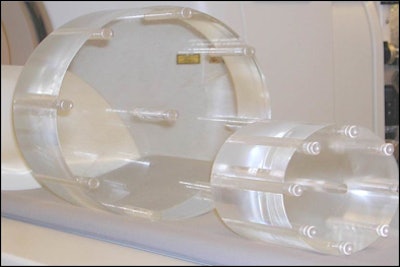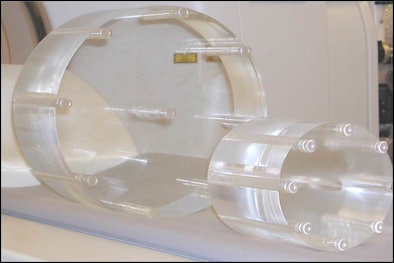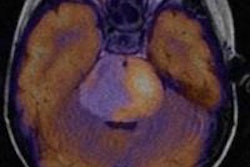
With all eyes on pediatric radiation dose these days, researchers from six children's hospitals in the U.S. are collaborating to build the first pediatric CT dose index registry. The group is beginning with a study to set pediatric abdominal CT diagnostic reference dose levels based on patient size.
Called the Quality Improvement Registry in CT Scans in Children (QuIRCC), the research is aimed at fulfilling a U.S. Food and Drug Administration (FDA) mandate to reduce overall radiation exposure levels -- a mandate exemplified by the May 9 FDA announcement that it will begin requiring manufacturers to design scanners with pediatric imaging in mind.
While the new FDA program focuses on scanner instrumentation as a means to reduce dose, the QuIRCC project is designed to help healthcare providers "child-size" their scanning protocols by giving them a better metric to measure radiation exposure. QuIRCC establishes typical dose settings through surveys and then pares them, based on patient size, to levels that are significantly reduced while remaining diagnostic.
Lack of reference ranges
"In February 2010, the FDA began its initiative to reduce unnecessary radiation exposure for medical imaging," said Dr. Marilyn Goske in a presentation last month at the Society for Pediatric Radiology (SPR) meeting in San Francisco. "They targeted fluoroscopy, nuclear medicine, and CT and encouraged development of diagnostic reference levels for all of these imaging modalities."
The lack of diagnostic reference ranges (DRRs) in the U.S. stands in stark contrast to Europe, which has led in the development of reference dose levels, said Goske, a radiologist from Cincinnati Children's Hospital Medical Center. "There is no regulation of dose levels, and typical dose levels for pediatric exams are not known in the U.S.," she said.
QuIRCC's exposure levels are expressed as diagnostic references levels (DRLs) between 25% and 75% of typical exposure levels, she said. The survey-derived levels enable facilities to compare their practices to those of their peers.
"The goal is for the dose to be less than 75% compared to peers for the same type of exam for patients of similar size," she said. The 25% to 75% range encompasses a lower limit (25%) of acceptable image quality, defined as the radiation dose below which the image is nondiagnostic, and an upper limit (75%), above which the radiation dose may be excessive, Goske explained.
Based on this range, Goske and her QuIRCC co-investigators, including Keith Strauss; Laura Coombs, PhD; Dr. Michael Callahan; Dr. Kassa Darge, PhD; and Dr. Donald Frush, expanded the definition of DRLs to the term diagnostic reference ranges.
To improve the quality of CT scans nationally, hospitals' dose ranges should fall within a national target range. Practices can use quality improvement methodology to arrive within these national standards, Goske explained.
"The purpose of our study was to develop some national target ranges for CT of the abdomen based on body size," she said. "We examined the relationship between existing CT protocols within the consortium and an improved estimate of patient dose called SSDE, or size-specific dose estimate," she said.
Developed by the American Association of Physicists in Medicine (AAPM) Task Group 204, SSDE, which is derived from CT dose index volume (CTDIvol) and correction factors, beats other dose measurements for accuracy -- falling within 10% to 20% of actual patient dose based on phantom studies, Goske said.
 |
| Acrylic 16-cm head phantom and 32-cm body phantom used to develop pediatric SSDE for the ongoing QuIRCC study. Image courtesy of Keith Strauss and Dr. Marilyn Goske. |
"I believe our study is one of the first to discuss the use of the AAPM Task Group 204's new size-specific dose estimate," Goske wrote in an e-mail to AuntMinnie.com.
Six children's hospitals formed the QuIRCC study team, which retrospectively reviewed contrast-enhanced abdominal CT scans in patients ages 18 years or younger. A total of 106 images were selected from the lowest, first-quartile, and median SSDE values based on the survey of hospitals. Six radiologists reviewed three images from each case under identical viewing conditions, rating them for subjective image quality. Cases were deemed nondiagnostic if three or more viewers reached that conclusion.
Six cases were deemed nondiagnostic, but four of these were acquired at less than the 10th percentile radiation dose level for SSDE. In addition, five of the six nondiagnostic cases were acquired at less than the 25th percentile of dose, Goske said. One nondiagnostic case acquired below the 25th percentile was degraded due to a metal implant.
The results based on clinical images acquired over a three-month time period showed a wide range in volume from the six participating hospitals, ranging from 50 to 350 cases. Among the six institutions labeled A through F, hospital A had the lowest mean dose, hospital F had the highest mean dose, and both extremes differed significantly from the four hospitals in the middle range, Goske said.
Diagnostic reference ranges based on SSDE
|
|||||||||||||||||||||||||||||
Among the dose results, the QuIRCC 75th percentile level using CTDIvol for a 5-year-old is 7.1 mGy, 30% lower than the American College of Radiology's published CT accreditation data, Goske said.
"We provided diagnostic reference ranges in response to the FDA mandate and established an upper estimated patient dose reference level above which patient doses may be in excess, and a minimum dose below which interpretation may be compromised," she said of the study.
"The concept of DRR begins to address the balance of a reasonable radiation dose that maintains adequate image quality based on patient size," Goske noted.
The QuIRCC consortium plans to provide diagnostic reference levels for other body parts, as well. "I believe we will move onto the chest next," she said.




















